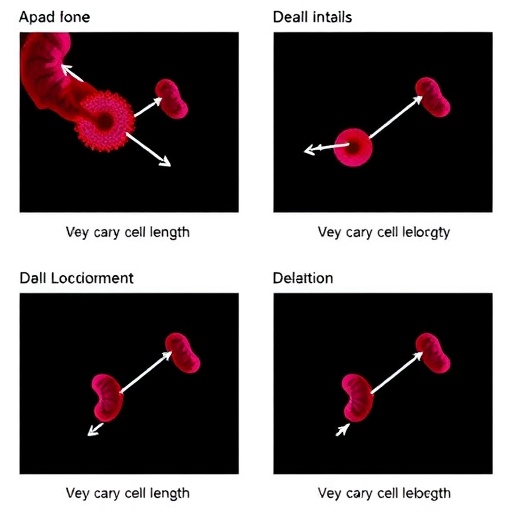Recent research conducted by Parwin and Srivastava has opened new avenues in our understanding of bacterial morphology, particularly through their examination of the effects of deletion mutants of various divIVA genes in Rhodococcus erythropolis PR4. Their study documents the peculiarities associated with altered cell length in these mutants, a topic that could have widespread implications in the field of microbiology. The significance of understanding cell morphology cannot be understated, as it plays a crucial role in bacterial growth, division, and adaptation to various environmental conditions.
The divIVA gene is a well-known pleiotropic gene involved in the regulation of cell shape and division in several bacterial species, notably in Bacillus subtilis. In the case of Rhodococcus erythropolis, which is recognized for its ability to degrade a variety of environmental pollutants, the role of divIVA takes on added significance. The deletion of specific alleles of this gene can lead to notable morphological changes, including variations in cell length that might affect its metabolic capabilities.
The researchers employed a systematic approach, using genetic engineering techniques to create deletion mutants of the divIVA genes. Through a series of controlled experiments, they measured the resultant cell lengths of these mutants using advanced microscopy techniques. The results revealed a fascinating correlation between the deletion of specific divIVA genes and the elongation or shortening of cell lengths. These observations not only underline the multifaceted role of divIVA in maintaining proper cellular architecture but also suggest that modifications in cell length may have adaptive implications.
One of the critical insights from their research is the potential mechanism by which divIVA controls cell length. It appears that the gene is involved in the localization of proteins necessary for cell wall synthesis, which directly impacts how bacteria regulate their growth. This novel understanding of divIVA prompts further investigation into its interactions with other cellular processes, including how it may coordinate with factors influencing cell division.
Research into bacterial morphology is increasingly relevant, especially considering the rising prevalence of antibiotic resistance. Anomalies in cell shape often correlate with antibiotic susceptibility. Thus, by mapping out how the deletion of divIVA genes alters cell length, researchers may identify new strategies to combat resistant strains of bacteria. The implications are far-reaching, considering that understanding these cellular mechanisms may lead to innovative approaches in drug design.
Furthermore, future directions in this research might explore the interactions between Rhodococcus erythropolis and various environmental factors that lend themselves to shaping cell morphology. Given the bacterium’s ecological role as a bioremediator, its ability to adapt to pollutants presents a compelling backdrop for this study. Insights into how divIVA influences cellular architecture can enhance our understanding of microbial ecology in contaminated environments.
The impact of such foundational research extends beyond mere morphological curiosity; it touches on evolutionary biology, where changes in cellular attributes can lead to adaptations over time. As bacteria evolve and face new challenges, the role of structural genes like divIVA could be crucial in facilitating survival. Thorough investigation into the evolutionary pressure exerted on such genes could yield critical insights into how bacteria evolve in the face of environmental changes.
Moreover, understanding the implications of divIVA gene deletions could lead to advances in synthetic biology, particularly in designing microorganisms with tailored features for environmental or industrial applications. The engineering of Rhodococcus erythropolis to produce specific enzymatic functions may be facilitated by manipulating genes that also influence cell shape, thereby optimizing the bacterium for particular tasks, such as pollutant degradation.
As we delve deeper into the molecular mechanisms at play, it becomes increasingly clear that the seemingly simple aspect of cell length holds immense complexities. The interplay of various genes and their products to regulate cellular morphology is a testament to the intricacies of bacterial life. Parwin and Srivastava’s findings lay a foundation for further exploration, urging scientists to seek a holistic understanding of how structural genes impact biological systems as a whole.
In terms of practical applications, these findings could steer the field towards developing more effective bacterial strains for waste cleanup operations. By leveraging the molecular insights gained from studying the divIVA gene, researchers may enhance the efficacy of bioremediation strategies, thereby benefiting environmental sustainability efforts.
In conclusion, the investigation into the divIVA genes in Rhodococcus erythropolis PR4 by Parwin and Srivastava serves not only as a relevant piece of scientific inquiry but also as a catalyst for broader discussions regarding microbial adaptability, evolutionary mechanisms, and potential biotechnological innovations. As microbiology continues to engage with complex biological questions, studies like this highlight the boundless possibilities that arise from unraveling the fundamental aspects of bacterial life.
The ongoing research into deletion mutants unveils new dimensions of scientific inquiry that actively contribute to our collective understanding of cellular biology. As we stand on the cusp of biotechnological advancement, understanding the nuances of cell morphology may unlock unprecedented solutions to some of the pressing challenges in microbiology.
These developments undeniably push the boundaries of our knowledge, revealing the astonishing flexibility and adaptability of microorganisms in a world of rapid change. The journey ahead in deciphering the complexities of the divIVA gene and its implications for bacterial physiology and ecology promises to be as enlightening as it is important.
As we reflect on the various implications of this research about divIVA, it is clear that this study is the beginning of a broader exploration that will reverberate through the scientific community and beyond, fostering innovative ideas that transcend traditional boundaries in microbiology.
Subject of Research: Altered cell length in deletion mutants of the different divIVA genes in Rhodococcus erythropolis PR4
Article Title: Altered cell length in deletion mutants of the different divIVA genes in Rhodococcus erythropolis PR4
Article References: Parwin, S., Srivastava, P. Altered cell length in deletion mutants of the different divIVA genes in Rhodococcus erythropolis PR4. Int Microbiol (2025). https://doi.org/10.1007/s10123-025-00702-2
Image Credits: AI Generated
DOI: https://doi.org/10.1007/s10123-025-00702-2
Keywords: divIVA, Rhodococcus erythropolis, cell length, deletion mutants, microbial ecology, bioremediation, bacterial morphology, antibiotic resistance, synthetic biology.




